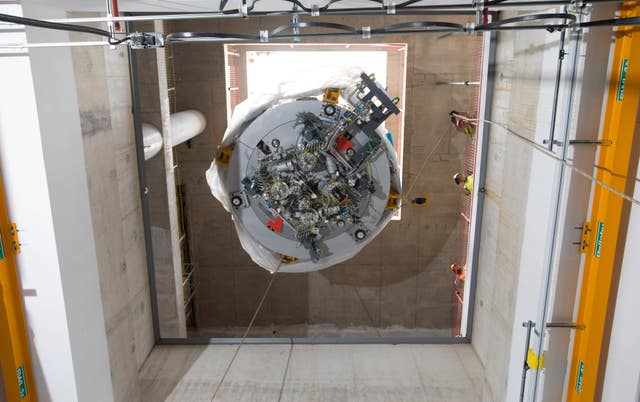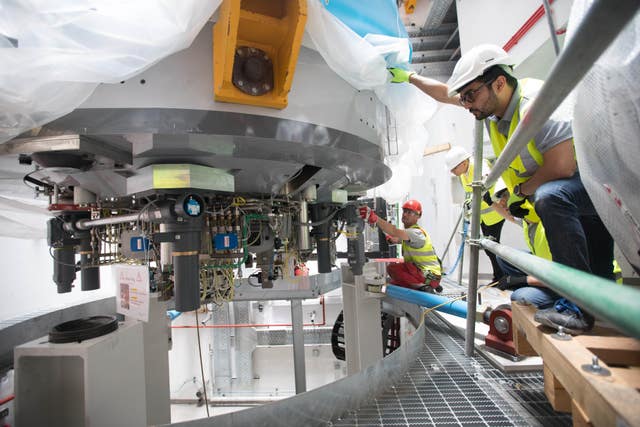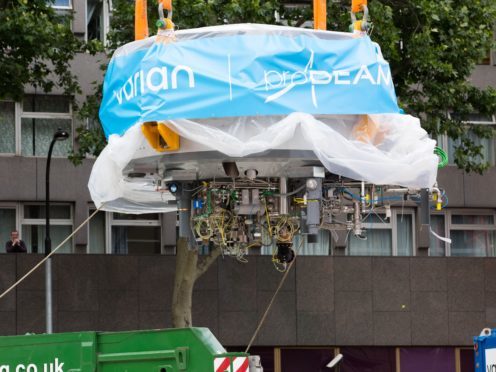A 90-tonne piece of cancer-fighting equipment that will improve the lives of hundreds of cancer patients every year has been carefully lowered into place in its new home.
The size of a family car and weighing the same as seven London buses, the cyclotron is described as the “beating heart” of the new proton beam therapy centre at University College London Hospital (UCLH).
The site is one of two new proton beam therapy (PBT) centres to be opened in the UK, with the other at the Christie NHS Foundation Trust in Manchester, meaning NHS patients no longer have to be sent abroad for the treatment.
PBT is an advanced form of radiotherapy that uses charged particles instead of X-rays to treat patients with cancer.

It means the proton beams can accurately target cancer tumours with minimal damage to surrounding healthy tissue, helping increase success rates, reducing side-effects and enabling patients to recover quicker.
It can also protect fertility, IQ or growth and reduce the risks of developing a radiation-induced new cancer in the future or the need for life-long hormone replacement.
Having travelled 400 miles from Germany via the Netherlands, the machine was lowered into a specially-constructed vault by a crane at the central London site on Tuesday afternoon – a key milestone in the construction of the 11-storey facility.
Contractors had to excavate 80,000 cubic metres of earth – the equivalent of 640 double decker buses, or enough to make 39,000,000 bricks – to create a home for the equipment in the building, which has five storeys below ground and six above, with a total height equivalent to that of London’s Tower Bridge.
Creating the beam of protons has been described as a “feat of physics and engineering”.

The cyclotron is cooled to -269C and spins ionised hydrogen at two-thirds the speed of light.
This creates the beam of protons that is then guided via massive magnets to the treatment room, where a three-storey machine delivers the treatment to the patient with millimetre accuracy.
The London PBT centre is not due to open until 2020, but NHS patients will be able to be treated at the Christie when it opens later this year.
The two centres are being built following £250 million of Government funding.
Previously, eligible NHS patients had to be sent overseas for the therapy. A funding programme has seen more than 1,200 patients treated abroad since it was established in April 2008.
I have a really important job. I create the beam of protons that are used in a special form of #radiotherapy called #ProtonBeamTherapy that is used to treat #cancer. Watch this clip to find out more: https://t.co/TCLTB7fNfy
— UCLH (@uclh) June 19, 2018
One of those helped by the programme was Emily Major, 26, who travelled to the United States to have PBT.
Ms Major, from London, said: “I had PBT back in 2015 in the States to make sure that my cancers were completely removed.
“Now I have regained my strength and enjoy my active life, working full time. It is really exciting seeing this new centre being built and it is great that it means people will be able to have PBT in London.”
Following a staff vote, the cyclotron has been named Lise, in honour of physicist Lise Meitner’s pioneering work in radioactivity and nuclear physics, including her role in the discovery of nuclear fission in the 1930s.
Here is a little bit more information about the person I am named after. #PBT #PBTatUCLH pic.twitter.com/0LJU5H8eTJ
— UCLH (@uclh) June 19, 2018
Marcel Levi, chief executive of UCLH, said: “With the NHS turning 70 this year, it is absolutely fantastic to be investing in world leading treatments and facilities.
“When the PBT centre opens, more adults, young people and children will be able to access this treatment, ensuring better recovery and fewer side effects than possible with other treatments.”
NHS England national medical director Steve Powis said: “Today marks an exciting milestone in the NHS’s continuing delivery of world-class cancer treatment.
“As the NHS celebrates seventy years of high-quality patient care, the arrival of this proton beam equipment is just one example of the innovative technology that the health service will be able to rely on in the years to come.”
